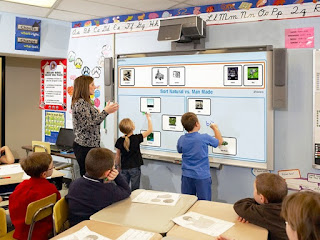Engage, enhance, and extend are three educational "buzzwords" that carry a whole lot of meaning. However, if we aren't sure of their meaning within the context of education, we can't use them correctly and to the benefit of our students. Many students fall victim to a teacher's lesson that engages them with technology, but does little to meet the learning needs or curriculum standards with its use. This is what Liz Keren-Kolb set out to correct when she wrote her article in Learning & Leading with Technology. By defining these terms and applying them to an actual lesson, Keren-Kolb illuminated the inherent differences between each of the words and explained their relevancy in education.
Engage
The purpose of engagement is to motivate a student to begin learning. Rather than being a passive learner that sits back and listens to a lecturing teacher, the student shifts their role to a learner that actively participates in the lesson. Teachers are great at this! They use Animoto, create a Glogster, or allow students to participate in an interactive whiteboard activity.
In many of my Educational Technology courses, I've learned to create an engaging "hook" to draw students into a lesson using technology. There are so many examples of tools that teachers can use to accomplish this goal, while also helping students gain deeper understanding of a standard. The following video is a great example of several technological tools, including WheelDecide, TodaysMeet, Puzzle Maker, and Direct Poll, that can be used in the classroom.
Out of all of these ideas, Direct Poll is my favorite! Direct Poll is a site that allows teachers to ask questions and get instant feedback from students using technology. This would be a fantastic element in a lesson because students actively participate using a tablet, computer, or iPhone. A teacher could use this to introduce a topic and gauge the overall understanding before teaching or a teacher could use this as a formative assessment to understand the whole class' understanding of a topic that has already been taught. Either way, students are active participants in the activity, which motivates students to take a greater stake in their learning.
Enhance
 Using technology to enhance learning involves employing technological tools in the classroom that make a difference in the understanding of a particular topic. The essential part of educational enhancement with technology is recognizing that its goal is to accomplish something, academically speaking, that could not be done without the technology present.
Using technology to enhance learning involves employing technological tools in the classroom that make a difference in the understanding of a particular topic. The essential part of educational enhancement with technology is recognizing that its goal is to accomplish something, academically speaking, that could not be done without the technology present. A great example that I'd love to use with my students one day is having students create "podcasts" to demonstrate their research on a subject. Students would work in pairs to record themselves talking about their research in a creative way and interview relevant people during the podcast. These podcasts would be posted to a class webpage, where other groups would listen to podcasts to learn about classmates' findings. Students could incorporate polls or other interactive features to go along with their podcasts to enhance their research. Finally, students would also conduct reviews of the podcasts by commenting on them and having a discussion about the content with their peers, demonstrating that they've learned about and retained the content.
The reason that this is an enhancement in the classroom is because students would not otherwise be able to do something like this without technology present. This is a fully online project that requires students to engage in recording and mastery of content. Additionally, students engage in online interaction to show deeper understanding and their ability to interact with features on a webpage. A great website, EdTechTeacher has a wealth of information about podcasting in the classroom and even provides free websites to use when podcasting with students.
By combining engage and enhance, teachers already are motivating students to work hard and deepening understanding throughout their lesson. However, they do not need to stop there!
 Extend
ExtendTo extend a lesson with technology is to extend learning beyond the boundaries of the classroom and apply learning to relevant parts of students' lives.
The best way to do something like this is by doing what is interesting to students and connecting students to the community around them. A teacher in Texas involved in the National Writing Project actually uses technology to help students establish partnerships beyond the walls of their schools (Kelleher, 2014).
Her students use social media to reach out to authors, scientists, and engineers and ask them relevant questions about their work. They also use blogging sites to express their ideas and invite these professionals to view or comment on them. Additionally, their peers respond to posts and interact outside of the classroom as a part of their assignments. This extended learning is happening beyond the school day and has an element of choice involved, making the assignments relevant to students and responsive to their interests.
Although each of these elements hold value individually, a lesson can be so much more effective when each of these elements have been integrated together. Students actively participate, they learn the content in a deep and meaningful way, and they connect their learning to their lives. By combining the three elements, students walk away from a lesson more accomplished and with a greater depth of knowledge than they would have without technology.
References
Kelleher, M. (2014, May 19). How can we make learning relevant to today's students? Retrieved September 9, 2016 from http://remakelearning.org/blog/2014/05/19/how-can-we-make-learning-relevant-to-todays-students/
Keren-Kolb, L. (2013, May). Engage, enhance, extend learning! Retrieved September 9, 2016 from http://files.eric.ed.gov/fulltext/EJ1015177.pdf
[Students at board]. Retrieved September 9, 2016 from http://teacher2mom2tech.weebly.com/uploads/2/1/4/3/21439042/7824427_orig.jpg?463
[Students with technology]. Retrieved September 9, 2016 from http://resources0.news.com.au/images/2010/11/17/1225954/823600-ipad-learning.jpg
[Students with technology]. Retrieved September 9, 2016 from http://resources0.news.com.au/images/2010/11/17/1225954/823600-ipad-learning.jpg


No comments:
Post a Comment